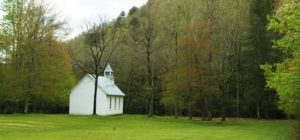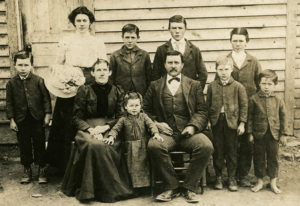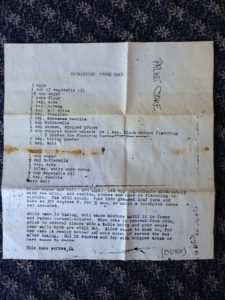by Sarah Bryan

In some ways the border between the Carolinas is fluid. The two largest towns that are on or a few miles from the state line—Charlotte and Myrtle Beach—seem mismatched with their respective states. Charlotte could be mistaken for a bustling, shiny, businesslike version of the self-image of the state to the south, and Myrtle Beach for a vacation outpost of its northern neighbor. Of course, Charlotte’s history is an inextricable part of North Carolina history, and vice-versa. Myrtle Beach for its part has plenty of cultural roots in the history of South Carolina Lowcountry (after all, many consider the Lowcountry to extend all the way north to Wilmington), as well as with the Upcountry, which supplied a significant part of the population and investment that made early Myrtle Beach grow into the large resort that it is today.
But many old families from Myrtle Beach (yes, there are old Myrtle Beach families) have deep ties to the state of North Carolina. As a member of one of those families, spending my childhood in Myrtle Beach, it seemed to me that North Carolina was almost as much my home state as South Carolina. Two of my grandparents were North Carolinians, we watched Tar Heel basketball avidly, and my parents loved eastern North Carolina barbecue (we always stopped in Weldon on our way to and from my mom’s hometown in Virginia). Most noticeably, we, like most Myrtle Beach natives, had and have distinct Piedmont North Carolina accents. You’ll hear the occasional Lowcountry-ism in Myrtle Beach speech—we call the Cooper River the “Couppa,” for example, as Charlestonians famously do, or a hybridized “Coupper”—but for the most part we have the sharp twang of the Piedmont.
Myrtle Beach also has ties to the mountains of North Carolina. Some of the early families came to the beach from the mountains. And just as many North Carolinians come to Myrtle Beach in the summer, many people from Myrtle Beach go to the North Carolina mountains to get away from the heat and crowds. My father, growing up in the 1930s and ‘40s, often went to the area around Linville Falls to visit his grandparents, who had retired there after a lifetime spent following my great-grandfather’s career as a Baptist minister in churches throughout Alabama and the Carolinas. Daddy went to Camp Chimney Rock as a boy, and we have a letter that he wrote back to his mother at the beach, written on Chimney Rock stationery.
Daddy’s first cousin Lynn, the daughter of my great-aunt Jakie Bryan Epps, also went to camp in the North Carolina mountains, to the Cataloochee Guest Ranch, and her visits there are the genesis of one of my family’s most familiar holiday recipes: Cataloochee Prune Cake.
Today the Cataloochee Guest Ranch is located in Maggie Valley, but originally its home was the Cataloochee Valley, inside the present boundary of the Great Smoky Mountains National Park. The region that is now home to a famous herd of reintroduced elk, and is one of the most visited, though remote, sections of the Park, had been populated for generations before the Park. It belonged first to the Cherokee people, who made use of it as a fertile area for hunting and fishing. In the early nineteenth century the valley began to be home to white settlers, who would eventually be concentrated in two thriving communities, Big Cataloochee and Little Cataloochee. Early economic ties were established to South Carolina, as Cataloochee men drove livestock to market all the way to Charleston. The valley is said also to have been a pocket of Confederate sympathy during the Civil War, unusual for a community deep in Appalachia. By the twentieth century the valley’s two towns were firmly established, home to many houses and farms, as well as churches, shops, and three schools.

The coming of the Great Smoky Mountains National Park brought the end of the valley’s history as a populated region. The land was taken by eminent domain, with some residents bought out and made to resettle elsewhere, and others granted lifetime leases that eventually ceded the land to the Park. Like it was for the residents in Virginia’s Blue Ridge who were forced to leave their homes to make way for the Shenandoah National Park, the transition was life-altering for the Cataloochee people, and for many, no doubt, deeply wrenching.
Among the businesses that had to relocate was the Cataloochee Ranch. Like many people in the valley, the owners moved to another part of Haywood County. The Ranch’s website gives a little bit of its history:
“Cataloochee Ranch was founded by “Mr. Tom” and “Miss Judy” Alexander in 1933 and was originally located in the serene and beautiful Cataloochee Valley. In 1938 Mr. Tom purchased a large part of the present Ranch property on Fie Top Mountain from Verlin Campbell, the “Potato King” of Haywood County. From Verlin he inherited a sturdy stone and log cattle barn, now the main Ranch house, and several derelict cabins and sheds. The eroded pasture land was littered with stumps and old potato crates, but it provided a number of excellent “bold” springs. Its 5,000-foot elevation bordering the Great Smoky Mountains National Park also created the ideal combination of extraordinary mountain views and wonderfully cool summer temperatures.”
Miss Judy was a renowned hostess, and word of her cooking and baking skills traveled as recipes that she originated made their way around the world. My relatives’ Cataloochee Prune Cake is an example. Many years ago my great-aunt Jakie gave me a photocopy of her typed version of the recipe. On the back, she shared this history:
“Lynn Epps Hardee (my daughter) went to Cataloochee, NC, in the early sixties (1961 or ’62) with friends to ride at a horse ranch. The father and a couple of his children took them on all-day or even overnight trail- rides. The mother stayed home and cooked wonderful meals. Lynn said she even made “home-made rolls” for the hot-dogs and hamburgers. One child stayed home [at the ranch] to bring the next meal to the riders. This Cataloochee Prune Cake recipe was one of the desserts.”

Every year Jakie and her husband Big Claude would host a Christmas party for family and friends. These gatherings always featured Cataloochee Prune Cake, made either by Jakie, or by Alifair “Alfa” Holloman, who worked for the Epps family as a cook for many years. My cousin Bryan, one of Jakie’s granddaughters, says that she and her brother Merrimon still make the cake; Bryan recommends topping it with Cool Whip.
Nearly all of the cousins of my generation now live away from Myrtle Beach. The town has changed tremendously over the nearly forty years of my memory, and— though we weren’t compelled to leave like the people of the Cataloochee Valley, and we can go home to visit friends and family who still live there—I still feel a great deal of nostalgia for a place that used to be.
Here’s the recipe, as recorded by my great-aunt Jakie:
Cataloochee Prune Cake
3 eggs
1 C of vegetable oil
1 1/3 C sugar
2 C flour
1 t soda
1 t nutmeg
1 t allspice
1 t cinnamon
2 t vanilla
1 C buttermilk
1 C cooked, chopped prunes
1 C chopped black walnuts or 1 t black walnut flavoring [Jakie notes, “I prefer the flavoring instead of the nuts.”]
2 t baking powder
1 t salt
SAUCE
1 C sugar
½ C buttermilk
1 t soda
2 T white corn syrup
½ C vegetable oil
1 t vanilla
dash salt
Blend sugar and oil. Add eggs. Add dry ingredients alternately with the milk. Add vanilla, prunes and nuts or flavoring to the mixture. Mix with spoon. Pour into greased loaf pans and bake at 300 degrees F for 35 minutes, or until a toothpick comes out uncoated.
While cake is baking, boil sauce mixture until it is foamy and rather caramel-colored. When cake is removed from oven, prick in several places with a table knife and pour sauce over while both are still hot. Allow sauce to soak in, for the cake is really better and more moist if served the day after baking. Cut in squares and top with whipped cream or hard sauce to serve. This cake serves 24.
Leave a Reply